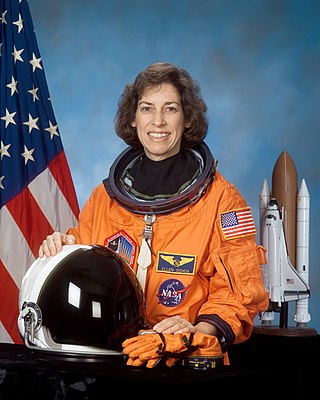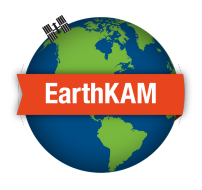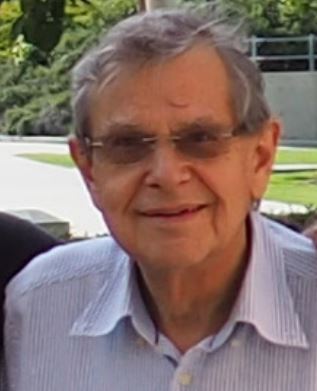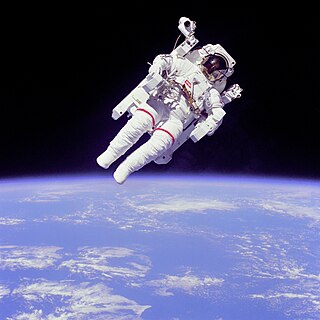
The Explorers program is a NASA exploration program that provides flight opportunities for physics, geophysics, heliophysics, and astrophysics investigations from space. Launched in 1958, Explorer 1 was the first spacecraft of the United States to achieve orbit. Over 90 space missions have been launched since. Starting with Explorer 6, it has been operated by NASA, with regular collaboration with a variety of other institutions, including many international partners.
In radio communication, a transceiver is an electronic device which is a combination of a radio transmitter and a receiver, hence the name. It can both transmit and receive radio waves using an antenna, for communication purposes. These two related functions are often combined in a single device to reduce manufacturing costs. The term is also used for other devices which can both transmit and receive through a communications channel, such as optical transceivers which transmit and receive light in optical fiber systems, and bus transceivers which transmit and receive digital data in computer data buses.

Ellen Ochoa is an American engineer, former astronaut and former director of the Johnson Space Center. In 1993, Ochoa became the first Latina woman to go to space when she served on a nine-day mission aboard the Space Shuttle Discovery. Ochoa became director of the center upon the retirement of the previous director, Michael Coats, on December 31, 2012. She was the first Latina director and the second female director of Johnson Space Center.

Paul William Richards is an American engineer and a former NASA astronaut. He flew aboard one Space Shuttle mission in 2001.

The Defense Meteorological Satellite Program (DMSP) monitors meteorological, oceanographic, and solar-terrestrial physics for the United States Department of Defense. The program is managed by the United States Space Force with on-orbit operations provided by the National Oceanic and Atmospheric Administration (NOAA). The mission of the satellites was revealed in March 1973. They provide cloud cover imagery from polar orbits that are Sun-synchronous at nominal altitude of 830 km (520 mi).

Dextre, also known as the Special Purpose Dexterous Manipulator (SPDM), is a two-armed robot, or telemanipulator, which is part of the Mobile Servicing System on the International Space Station (ISS), and does repairs that would otherwise require astronauts to do spacewalks. It was launched on March 11, 2008, on the mission STS-123.

Sally Ride EarthKAM is a NASA educational outreach program started in 1996. The program was initiated by JoBea Way Holt, an Earth scientist from NASA's Jet Propulsion Laboratory, and was initially named KidSat. It allowed students to direct a digital camera aboard a series of space shuttle flights to take photographs of specific places on Earth. In 1998, KidSat was co-opted Dr. Sally Ride, the first American woman in space and renamed EarthKAM. Dr. Ride directed the installation of camera equipment on the International Space Station (ISS), where it became a permanent fixture independent of shuttle flights.

The Space Transportation System (STS), also known internally to NASA as the Integrated Program Plan (IPP), was a proposed system of reusable crewed space vehicles envisioned in 1969 to support extended operations beyond the Apollo program. The purpose of the system was two-fold: to reduce the cost of spaceflight by replacing the current method of launching capsules on expendable rockets with reusable spacecraft; and to support ambitious follow-on programs including permanent orbiting space stations around Earth and the Moon, and a human landing mission to Mars.
Spacecraft collision avoidance is the implementation and study of processes minimizing the chance of orbiting spacecraft inadvertently colliding with other orbiting objects. The most common subject of spacecraft collision avoidance research and development is for human-made satellites in geocentric orbits. The subject includes procedures designed to prevent the accumulation of space debris in orbit, analytical methods for predicting likely collisions, and avoidance procedures to maneuver offending spacecraft away from danger.

Edward Carroll Stone is an American space scientist, professor of physics at the California Institute of Technology, and former director of the NASA Jet Propulsion Laboratory (JPL).
The Architecture Design and Assessment System (ADAS) was a set of software programs offered by the Research Triangle Institute from the mid-1980s until the early 1990s.

Goddard Space Flight Center is NASA's first, and oldest, space center. It is named after Robert H. Goddard, the father of modern rocketry. Throughout its history, the center has managed, developed, and operated many notable missions, including the Cosmic Background Explorer, the Hubble Space Telescope, the Tracking and Data Relay Satellite System (TDRSS), the Lunar Reconnaissance Orbiter, and the Solar Dynamics Observatory.

The NASA Launch Services Program (LSP) is responsible for procurement of launch services for NASA uncrewed missions and oversight of launch integration and launch preparation activity, providing added quality and mission assurance to meet program objectives. LSP operates under the NASA Space Operations Mission Directorate (SOMD).
NiTiNOL 60, or 60 NiTiNOL, is a Nickel Titanium alloy discovered in the late 1950s by the U. S. Naval Ordnance Laboratory. Depending upon the heat treat history, 60 NiTiNOL has the ability to exhibit either superelastic properties in the hardened state or shape memory characteristics in the softened state.
Epaminondas George Aristotle Alexander Stassinopoulos was an American astrophysicist, author, and Resistance member against the Nazis occupying Greece during World War II. He served as the Head of the Radiation Physics Office at NASA’s Goddard Space Flight Center until 2006, when he transitioned to Emeritus status until 2021. He was the author of numerous papers and articles in the field of space radiation.

Forman Arthur Williams is an American academic in the field of combustion and aerospace engineering who is Emeritus Professor of Mechanical and Aerospace Engineering at the University of California San Diego.
Alan Hugh Schoen was an American physicist and computer scientist best known for his discovery of the gyroid, an infinitely connected triply periodic minimal surface.

Charles Edward "Ed" Whitsett Jr. (1936-1993) was a USAF officer and NASA engineer specializing in solutions for effective human movement in zero gravity. The pinnacle of his work was the astronaut maneuvering unit (MMU) which enabled satellite rescue and repair. For this capability, Whitsett along with NASA, Martin Marietta, Bruce McCandless, and Walter W. Bollendonk received the 1984 Robert J. Collier Trophy for "the greatest achievement in aeronautics or astronautics in America."
Nacer E. Chahat is a French Algerian-American engineer and researcher at the National Aeronautics and Space Administration (NASA) Jet Propulsion Laboratory.











